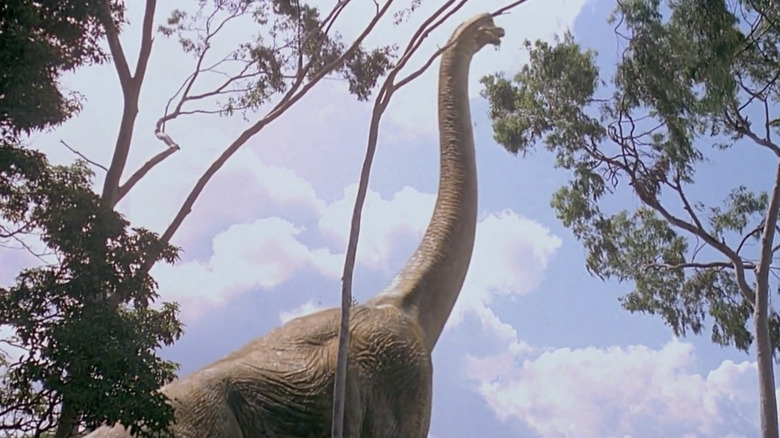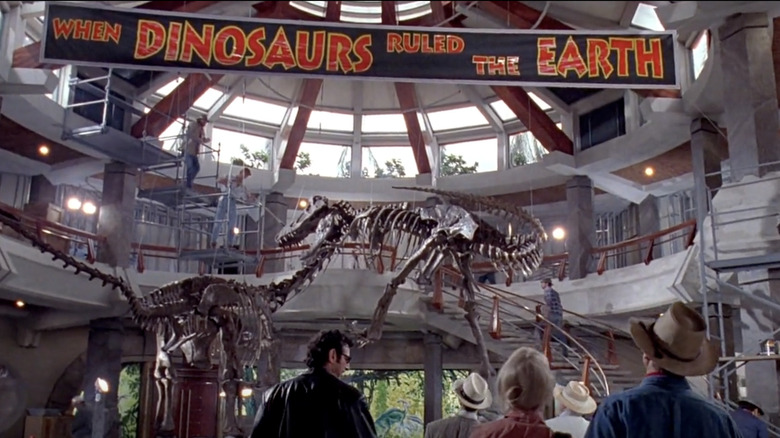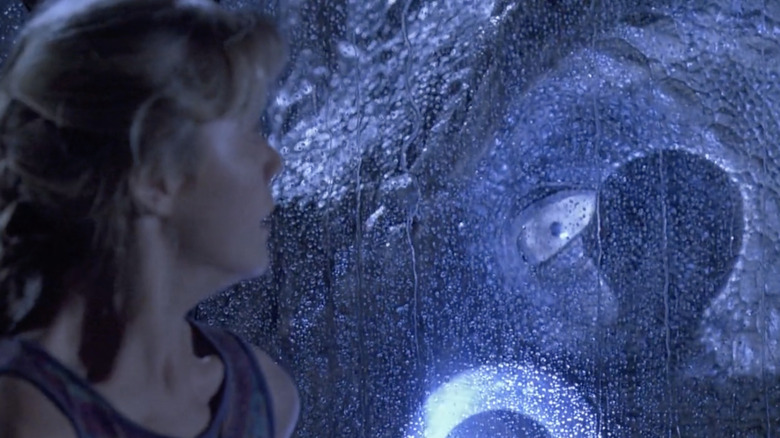Jurassic Park Continued The Legacy Of An Old-School Special Effects Legend
Steven Spielberg movies grab us by the collar, pop us into a world of wonder, and make us forget we're grown-ups with responsibilities. In his world, we're all curious children. After laying eyes on Spielberg's prehistoric creatures in "Jurassic Park," we all become that precocious kid peppering Dr. Grant (Sam Neill) with endless dinosaur questions.
The first dinosaur in the revolutionary film is a Brachiosaurus, but everyone knows the coolest one is the Tyrannosaurus rex. Her presence is hinted at by rippling water and a bloody goat leg smacking the roof of the tour Jeep. Then, she rises from the trees, opens her mouth of impossibly sharp teeth, and what's left of the goat falls down her throat. Several moments later, when the T. rex appears in the Jeep window beside a trembling girl, her yellow eyes narrow as if she's smiling.
I was barely 5 when I saw this movie, and the scene should've terrified me, but I was fascinated. I knew I was watching something amazing, but I didn't realize the groundbreaking technology needed to pull off such an amazing scene.
To create the dinosaurs for "Jurassic Park," Spielberg and his team would build upon a long legacy of stop-motion animation, combining the skills of animators with a brand-new technology called the Dinosaur Input Device.
The origins of stop motion
1933's "King Kong" was groundbreaking because it was the first film to star an animated character. Special effects pioneer Willis O'Brien's use of puppets and stop-motion techniques would become standard practice in Hollywood and laid the groundwork for Steven Spielberg's "Jurassic Park" 60 years later.
Special effects legend Ray Harryhausen watched "King Kong" back in '33. At 13, he was awed by the film and began experimenting with stop-motion techniques. At 18, Harryhausen worked with O'Brien to create the Academy Award-winning special effects for 1949's "Mighty Joe Young." He continued his work in the trade and created his own revolutionary technique called dynamation, in which hand-sculpted creatures are placed in front of a rear projection of a live-action film, making it appear as if the two are interacting. Using this technique, the animator was able to create scenes where people fight sword-wielding skeletons and run from Cyclopes. His work made an impression on a young Phil Tippett, who helped create the revolutionary digital dinosaurs of "Jurassic Park."
Thanks to Harryhausen, Tippett fell in love with animated creatures and stop-motion techniques, even creating a short film that featured animated dinosaurs. Because of his previous experience and knowledge of paleontology, he earned the role of stop-motion animator on "Jurassic Park."
The Dinosaur Input Device
Steven Spielberg had originally intended to use a mix of animatronics and stop motion to create his creatures, but the effects team thought it would be better suited for CGI, as the director remembered:
"One day I got a call from [visual effects supervisor] Dennis Muren at [Industrial Light & Magic], who already had the job of doing "Jurassic Park" with Phil Tippett, and Dennis said that he thought that he could pull off a full sized dinosaur that would be authentic to the eye, and, so, he started doing tests."
Tippett recalled to vfxblog the moment Spielberg decided to use CGI instead of stop motion:
"I went down with Dennis Muren when he presented the T. rex test to Steven and Steven went, 'Wow, that's what we're going to do,' and he asked me how I would feel and I said, 'I feel extinct.'"
Although Spielberg chose not to use traditional stop-motion techniques, Tippett's knowledge and expertise were still required. Back in the early '90s, CGI was in its infancy, especially when it came to creating creatures and animals with complex muscle movements, but Tippet was a pro. All his years of posing and moving puppets had given him a unique knowledge of animal's movements, which Spielberg knew his dinosaurs had to have.
Tippett and Muren combined their skills with the creation of the Dinosaur Input Device. Through the DID, Tippet operated a mechanical arm that was connected to a T. rex's skeleton. The skeleton had sensors that captured Tippett's movements and translated them to a digital version of the T. rex. Through the use of computers, the movements could be further tweaked and manipulated to appear more fluid and realistic than ever before.
The DID effectively ended the use of stop-motion animation, and it introduced the world to the staggering possibilities of CGI — not to mention the most badass dinosaurs to ever fill a 5-year-old's imagination.


